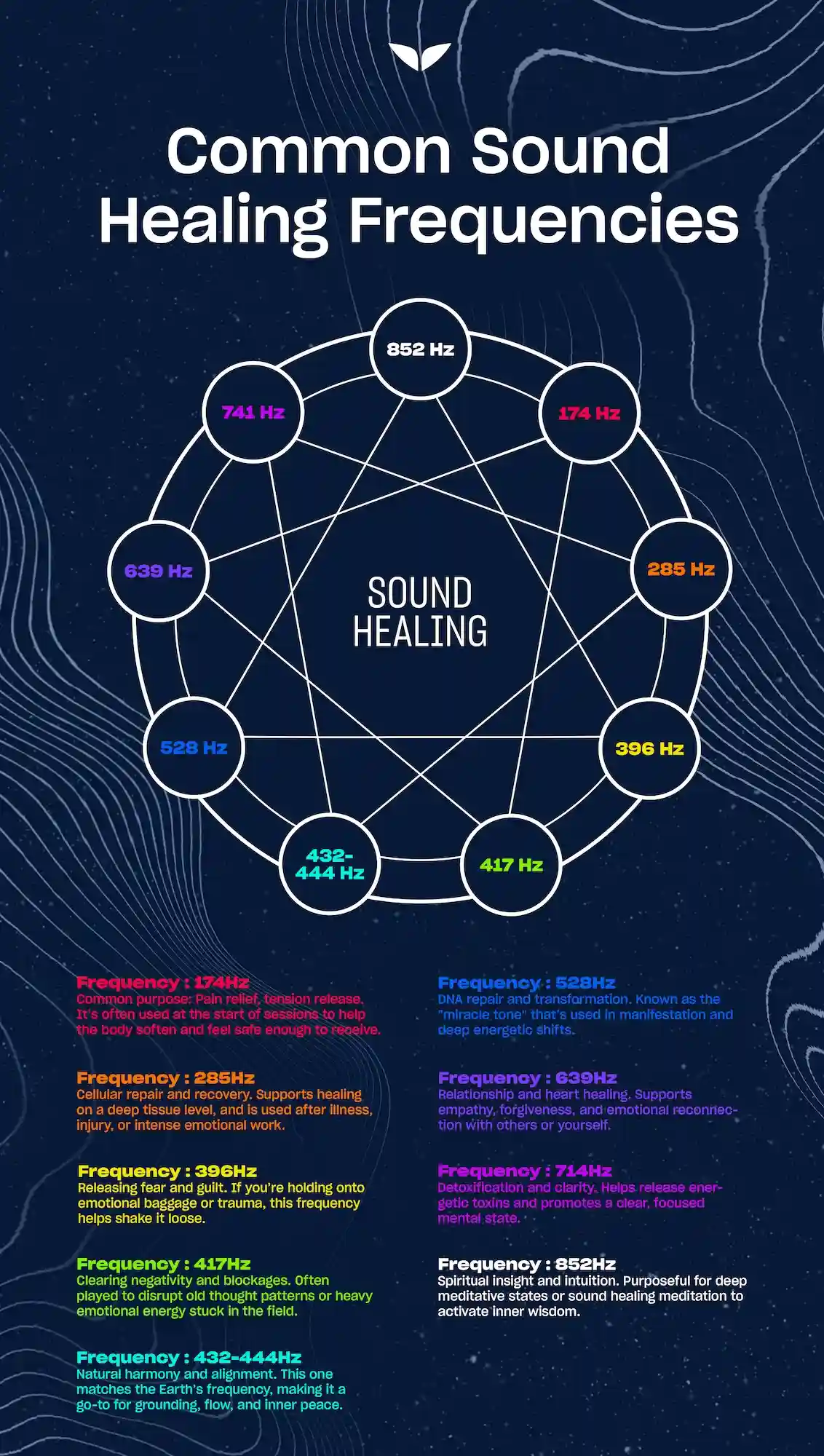You used to feel plugged in. Body sharp. Energy clean. Spirit lit.
Now you’re wired, tired, and crawling through the day like an iPhone on 1%.
You’ve tried everything: the green juices, nervous system reset exercises, adaptogens with names you can’t pronounce. Still, nothing holds.
Well, maybe the problem isn’t your effort. Maybe it’s your frequency, and here’s where sound healing can come to the rescue.
Believe it or not, it’s not just some “feel good” placebo trap. There’s real fact-based resonance behind this frequency medicine, and how it effectively calls your energy back home to you.
What is sound healing and what does science say?
Sound healing is frequency medicine. It’s a therapeutic practice leveraging specific vibrations of musical instruments and sound-based tools to bring the body back into energetic balance.
The whole process is akin to tuning a guitar, except the strings here are your cells, your organs, and your nervous system. Every system in your body resonates at its own frequency, from the steady rhythm of your heart to the electrical pulses firing your brain waves.
What’s more, these frequencies are constantly being pulled, stretched, and scrambled by the “noise” of your external environment. Because the human body isn’t just skin, muscle, and bones.
“You think you’re a solid being sitting there in a chair,” says Donna Eden, a pioneer in modern energy medicine in her Mindvalley program, Energy Medicine. “But I’m telling you: you’re latticeworks of force fields.”
Scientists refer to your whole vibrational energy as resonance. And it’s not foolproof; when stress or trauma knocks you out, it also knocks these frequencies out of sync. You’d know it from the way you suddenly experience fatigue, anxiety, brain fog, and even physical pain.
But here’s where sound healing can really make a huge difference. It gets your body to remember how to regulate itself by clearing all the energetic gunk that’s jamming your mojo.
Is sound healing scientifically proven?
Short answer? Yes. Long answer? Science is finally catching up to what ancient cultures have been vibing with for centuries.
Ancient Greeks, for one, prescribed melodies for the soul. Egyptian temples wove rituals around rhythm. Native American healers used it in sacred ceremonies. Even the U.S. military used music therapy to heal soldiers in World War II.
And today, researchers are understanding why:
- Sound frequencies can reduce tension and anxiety, help synchronize brainwaves, and support emotional regulation;
- Sound meditation that specifically uses singing bowls is seen to significantly decrease stress markers while bumping up spiritual well-being; and
- Binaural beats entrain the brain, promoting relaxation and mental clarity while at it.
The findings point to one common thing: in a world cranked to max volume, people are choosing resonance over noise. Just like their ancestors always have. Why? Because that’s what nature has ordered.
That’s why Dr. Mitchell Gaynor, an integrative oncologist, supports his conventional cancer treatments with sound therapy to help patients manage stress and support recovery. As he said in his book, The Healing Power of Sound: “If we accept that sound is vibration and we know that vibration touches every part of our physical being, then we understand that sound is heard not only through our ears but through every cell in our bodies.”
Common sound healing frequencies to know
“When you allow frequency to land, it clears anything in your field that’s not in resonance with the life you want to create,” explains manifestation expert Regan Hillyer in her Manifesting Mastery program on Mindvalley. No wonder she uses sound healing as one of her go-to modalities for manifestation.
Want a cheat sheet on what she’s talking about? Here’s a sound healing frequency chart to show how different waves are believed to support:
| Frequency (Hz) | Common purpose |
| 174 | Pain relief, tension release. It’s often used at the start of sessions to help the body soften and feel safe enough to receive. |
| 285 | Cellular repair and recovery. Supports healing on a deep tissue level, and is used after illness, injury, or intense emotional work. |
| 396 | Releasing fear and guilt. If you’re holding onto emotional baggage or trauma, this frequency helps shake it loose. |
| 417 | Clearing negativity and blockages. Often played to disrupt old thought patterns or heavy emotional energy stuck in the field. |
| 432 | Natural harmony and alignment. This one matches the Earth’s frequency, making it a go-to for grounding, flow, and inner peace. |
| 528 | DNA repair and transformation. Known as the “miracle tone” that’s used in manifestation and deep energetic shifts. |
| 639 | Relationship and heart healing. Supports empathy, forgiveness, and emotional reconnection with others or yourself. |
| 741 | Detoxification and clarity. Helps release energetic toxins and promotes a clear, focused mental state. |
| 852 | Spiritual insight and intuition. Intended for deep meditative states or sound healing meditation to activate inner wisdom. |
These frequencies aren’t just “folklore” material. They’re measurable, impactful, and increasingly supported by clinical studies.
Case in point: A study showed that low-frequency sound stimulation could potentially reduce symptoms of fibromyalgia, a chronic autoimmune disease that messes with your nerves, energy levels, and sleep quality. Meanwhile, in cancer research, focused ultrasound is now being used to open the blood-brain barrier so treatments can actually reach brain tumors.
In short, frequencies aren’t just abstract thingamajigs. No, they’re the real, intelligent “language” your body already speaks that quietly recalibrates you towards wholeness.

How does sound healing work?
Sound waves can slip past the overthinking, control-freak part of your brain and get straight to work where your past trauma and stress live: your body. “It works on a cellular level, reprogramming what’s stuck in your energetic field,” says Regan.
And there are many techniques to leverage the healing power of sound.
5 key sound healing techniques
From Tibetan bowls to tuning forks, there are many sound healing methods to work with. Each comes in different settings and taps into different frequencies, which begs the question: which one should you reach for?
Well, that depends on what you want to clear, shift, or realign within you.
Here’s the breakdown to help you get started.
1. Singing bowls
Think of these as the OG sound healers. Made from metal or crystal, singing bowls create deep, resonant tones that you don’t just hear but deeply feel.
When played, they flood your system with frequencies that help slow brainwaves, relax muscles, and drop you into a meditative zone.
Some practitioners link specific bowl frequency to a chakra or energy center in your body, leveraging the connection in their chakra healing or energy healing classes.
2. Tuning forks
These are precision tools for your energy field.
Each fork is tuned to a specific frequency, and, when activated near or on the body, it helps move stagnant energy, boost circulation, and rebalance organs or meridian points.
You can think of it like acupuncture but minus the needles and the wince.
3. Binaural beats and isochronic tones
Your brain waves set the tone for everything: focus, sleep, stress, and even your day-to-day mood. These two sound-based tools train those waves to shift into the state you want.
Binaural beats deliver slightly different tones to each ear. Your brain merges them into a third frequency, nudging you into a specific rhythm: alpha waves for the flow state, theta waves for intuition, and delta waves for deep sleep and healing.
Meanwhile, isochronic tones take a simpler route, delivering steady, rhythmic pulses that don’t need headphones to work.
So… two methods. Different delivery. But one common goal: to ease a world that runs on overstimulation.
4. Sound baths and chanting
A sound bath is a full-body reset wrapped in vibration. You lie down. Instruments like crystal bowls, gongs, chimes, and drums wash over you in waves.
The result? Your nervous system slows down. Your mind softens. And your energy blockages dissipate.
And remarkably, chanting does the same, but with your own voice.
Contrary to popular belief, it’s not about hitting the right notes, but rather, about activating vibration from the inside out. This modality can stimulate the vagus nerve, regulate breath, and release trapped emotions.
No wonder many sound healing meditation practices use chants as a core element to deepen the experience.
5. Shamanic drumming
This is sound therapy with ancient roots. Used in shamanic meditation sessions, repetitive drumming rhythms shift your brain into a trance-like theta state, a.k.a., the zone where deep healing, insight, and release happen.
The drum acts as a guide, beyond providing rhythmic beats. It clears stuck energy, grounds the body, and helps you connect to inner wisdom. The steady pulse is said to mimic the rhythm of the Earth, syncing your system back into harmony.
5 benefits of sound healing
Sound healing isn’t just “spa-day vibes.” It’s your body’s internal reset button, helping your system remember how to work its magic again.
When you allow frequency to land, it clears anything in your field that’s not in resonance with the life you want to create.
— Regan Hillyer, trainer of Mindvalley’s Manifestation Mastery program
And when this happens, the following benefits start showing up:
1. Less stress, less anxiety
Sound frequencies shift your nervous system out of overdrive. Even just a session with singing bowls can already ease tension, fatigue, and depression.
“Stress is the enemy of energy flow,” says Donna. “When energy doesn’t move, neither do you.”
Thankfully, sound vibrations can open those channels again.
2. Deeper, more restorative sleep
According to Donna, the body already knows how to heal; that’s how it’s naturally built. But what does it need from you? “The right signals,” she points out.
Cue binaural beats, which move your brain into slower wave states like delta, helping you slip into deeper sleep and stay there longer. Insomniacs, for one, report fewer disruptions, less dependence on sleep meds, and better shut-eye thanks to this solution.
3. Emotional release on a cellular level
Sound reaches where talk therapy sometimes can’t. As Donna reminds in her program, “Emotions are energy in motion. If they don’t move through, they stay stuck.”
The right frequencies can move stuck emotions in your body. From here, it’s easier to let go of past trauma and frustration without having to drastically dig them all up. This is especially a good option for people in situations where they can’t risk retraumatizing themselves.
4. Sharper focus, stronger clarity
“When energy patterns are scrambled, so is your thinking,” says Donna.
Sound healing helps unsnarl that internal static. Binaural beats and isochronic tones, for instance, are evidently capable of training your brain to hold attention longer and process information faster.
The result? You’re switched on, synced up, and running at optimal capacity again.
5. Stronger mind-body connection
Sound clears static in your energetic field, helping your mind and body communicate better. It’s how real alignment starts, not just spiritually but biologically.
The body already knows how to heal. Sound healing just hands it the mic.
“You’re not separate parts,” reminds Donna. “You’re an energy system. It all talks to itself.”
What is sound healing therapy?
If sound healing is the art of using frequency to reset the body’s rhythms, then sound healing therapy is its structured practice done with intention, tools, and a trained practitioner guiding the process. It’s, quite literally, frequency medicine in action.
And so many people are listening in.
In the U.S. alone, the sound therapy market was valued at USD 2.26 billion in 2024. And it’s projected to reach USD 4.80 billion by 2034, growing at a 7.8% CAGR.
So, it’s obvious: more people are craving non-invasive, non-pharmaceutical ways to heal. And sound, nature’s unsung hero, is meeting that desire.
What is a sound healing session like?
You’re lying on a mat, eyes closed, no phone in sight. A crystal bowl rings out beside you—clear, haunting, steady. The sound doesn’t just fill the room. It fills you.
Vibrations roll through your chest like ripples on water.
Then comes a chime. A gong. Maybe your own breath, finally uncoiling.
And one by one, the emotional baggage you’ve been carrying starts to dissipate because your cells are responding to the frequency therapy. Deeply, and on cue.
From here, you might feel:
- Warmth or tingling in your hands, chest, or spine,
- Tears welling up, seemingly out of nowhere,
- Spontaneous breath shifts, like an exhale you didn’t know you needed,
- Visuals or color pulses behind your eyes,
- Memories surfacing, only to pass like waves, or
- A sudden sense of calmness, like something left your body.
What happens here matters more than people may realize. Dr. Bruce Lipton, a renowned pioneer in epigenetics and proponent of sound therapy, notes that perception (not genes) shapes our biology. And sound, which influences your ability to perceive, has the power to reshape your state from the inside out.
“As soon as you start to tell yourself in your perception that you can’t do something anymore, then your biological system will adjust to prove you right,” he said once in an interview with The Huffpost.
So, what role does sound healing play in all of this?
You’ll remember what being whole feels like, because the new vibrational frequencies help quiet the mental noise shaped by stress, trauma, or outdated beliefs. In action, they shift the invisible signals your biology listens to.
And that, simply, is how you recalibrate from the inside out.
How to do sound healing: 5 expert-backed steps
You can’t just strike a bowl and expect miracles. Sound healing works best when your body’s tuned in and your energy system knows what to do with the new frequencies.
Here’s how to make the most of this modality, the Donna-approved way:
1. Set your intentions
Before any sound touches your system, decide what you’re clearing or calling in.
Donna teaches that energy follows thought. So plant a clear intention while holding your hands over your heart chakra. Breathe in through the nose, and out through the mouth.
Repeat the process at least three times.
Think of this step as setting up your internal “radio” before tuning the dial.
2. Prep your field
Healing frequencies can’t do their job if your system’s jammed. You need to clear the static first.
That’s why Donna always starts her healing work by turning on the body’s energy switches. These are the spots that control how energy flows through you.
Here’s what to do:
- Tap just under your collarbones. These are what Donna refers to as the K27 points, and they act like jump-starters for your energy pathways.
- Rub beneath your ribs and along your sides. These spleen points help your body process everything from food to stress.
- Thump the center of your chest. This wakes your thymus gland, the command center for your immune system and energy levels.
- March in place, tapping opposite hands to knees. This gets your energy crossing over, which is how your body naturally heals and rebalances.
Do each for 10 to 15 seconds, and you’ll feel more awake, centered, and ready to change.
3. Play and receive the right frequency
Now bring in the sound through a crystal bowl, a tuning fork, a vocal chant, or binaural beats. The goal isn’t just to hear it, but to let the specific frequency at play reverberate through your body and do its thing.
As Dona explains, the body recognizes crossover patterns, especially figure eights, as a universal healing language. So while the sound plays on, gently trace figure eights over your body with your hands. Doing this helps your energy sync, settle, and recalibrate.
It’s also a perfect moment to drop into a sound healing meditation. Try simple meditation techniques like mantra chanting, guided visualization, and body scanning to de-frazzle your nervous system while the sounds do their magic.
Curious to know what this process feels like? Try it at home first with a stress-soothing Mindvalley meditation:
4. Move stuck energy out
Movement gives emotions—energy in motion—somewhere to go.
Sway side to side. Hum. Tap your chest. Stretch. Let your body move however it wants. Movement helps shift what the sound unlocks.
Still feel heavy afterward? Do what Donna calls a “blowout”:
- Rub your hands together, then shake them off.
- Raise your arms overhead.
- Take a deep breath, and exhale sharply three times, throwing your arms down.
The whole process is like sweeping stale air out of your field.
5. Ground and seal
Before you get up and return to your day-to-day routine, don’t forget to ground yourself. If you don’t? You risk feeling spacey, ungrounded, or even more drained than when you started.
Here’s how to ground and seal your field, in true Donna Eden style:
- Rub the bottoms of your feet with a stainless steel spoon. This resets your body’s polarity so you stay connected to the earth.
- Smooth your hands down your legs. Think of this as brushing off static and anchoring your energy downward.
- Zip up the front of your body from the pubic bone to the lower lip. Use your palm like you’re zipping a jacket. This protects your energetic field. Seal it with an imaginary lock at the top.
- Place one hand on your third eye, and one on your navel. Breathe here for a few slow counts. This “hook-up” move reboots your body’s electrical circuits and pulls your system back into your center.
With that, your energy’s aligned, your system’s sealed, and you’re ready to step back into the world without losing the great reset effect.
Frequently asked questions
Does sound healing work?
It’s time to stop Googling “Does sound healing frequency work?” Science is done debating because the answer’s a resounding yes.
Why? Your body’s already wired to get the memo.
And it’s not just that specific sound frequencies can regulate brainwaves, reduce anxiety, and help your system reset. It’s also a fact that sound healing is a powerful complementary tool for clinical care. For instance, binaural beats have been shown to reduce pre-surgery anxiety in patients, proving that sound can shift your state even in high-stress situations.
And here’s the kicker: you don’t need to be into chakras or quantum fields to feel the shift. Your nervous system is built to get the memo. And when it does, that’s proof that sound healing works when it’s done right.
Is sound healing real?
“But wait,” you ask. “Does sound healing frequency really work?”
So, you’re still incredulous. Well, it’s as real as your stress response, and that’s the point.
Sound healing uses vibration to influence your physical and energetic systems. Every cell in your body communicates through frequency. So when that frequency’s off due to stress, trauma, or overstimulation, sound frequencies help reset the signal.
“When energy doesn’t move, neither do you,” reminds Donna. Thankfully, sound works fast because it gets the energy moving again. And that’s how the body remembers to find balance amidst the chaos of life.
You’re not separate parts. You’re an energy system. It all talks to itself.
— Donna Eden, trainer of Mindvalley’s Energy Medicine program
What are the negative effects of sound healing?
There likely aren’t many. But if you go too wild with the tuning forks, your body just might clap back. Especially if you’ve got a lot to let go.
Sound healing can stir things up, emotionally, physically, and even chemically. And if your system’s already overwhelmed with stress, outdated patterns, and even old trauma, that shift can feel intense. And don’t be surprised if you face some emotional release, fatigue, or even lightheadedness after a session.
It’s also why Donna, in her energy healing work, often reminds people to “take it in small steps, just small steps.” Go too hard or too fast into frequency therapy, for one, and you might feel drained, foggy, or emotionally raw afterward.
And always come prepared for after-effects. “If too many toxins move into your body all at the same time… just drink some water, lay down for five minutes, and you’ll return,” she says.
Of course, if you’re experiencing persistent dizziness, nausea, or anything that feels off, talk to a medical provider. Like with any other form of spiritual healing work, sound healing isn’t a replacement for clinical care.
Supercharge your superpower
As Donna puts it, “The body learns fast. So go gently with the natural powers of sound healing, and “it’ll meet you there.”
And when you’re ready to harness your body’s natural healing abilities at the next level? You can sign up for her free Energy Medicine masterclass on Mindvalley.
In this prelude to her actual program, she’ll teach you to reclaim your energy and health from the inside out with:
- An instant energy booster: A 30-second trick to reset your system when your vitality crashes.
- No-nonsense stress fixes: Manage stress without spiraling with two energetic tools.
- Energetic food testing. Learn to muscle-test what nourishes you best (because newsflash: your body already knows).
- Her go-to kitchen utensil healing trick. Yes, you’ll learn how to use a stainless steel spoon to ground your energy fast and more.
Take it from Mfon Etukeren, a senior at Deloitte Tax LLP, on the radical change she’s experienced after joining the program:
Donna’s routine has [helped me] stabilize my narcolepsy, sleep apnea, and kept my immune system strong,” says “It’s changed my life for the better.
— Mfon Etukeren, a Mindvalley member
Consider Mfon’s story your invitation to stop outsourcing your wellness… and start leading it from within.
Welcome in.










